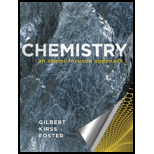
Chemistry: An Atoms-Focused Approach
14th Edition
ISBN: 9780393912340
Author: Thomas R. Gilbert, Rein V. Kirss, Natalie Foster
Publisher: W. W. Norton & Company
expand_more
expand_more
format_list_bulleted
Concept explainers
Expert Solution & Answer
Want to see the full answer?
Check out a sample textbook solution
Students have asked these similar questions
Which of these compounds is Ester formed from the reaction of acetic acid and one propanol 
Describe the four labeled parts of the reaction diagram from the reaction of sucrose, breaking down with and without an enzyme.
How to determine the product with mechanism showed
Chapter 21 Solutions
Chemistry: An Atoms-Focused Approach
Ch. 21 - Prob. 21.1VPCh. 21 - Prob. 21.2VPCh. 21 - Prob. 21.4VPCh. 21 - Prob. 21.5VPCh. 21 - Prob. 21.6VPCh. 21 - Prob. 21.7VPCh. 21 - Prob. 21.8VPCh. 21 - Prob. 21.9VPCh. 21 - Prob. 21.10VPCh. 21 - Prob. 21.11VP
Ch. 21 - Prob. 21.12VPCh. 21 - Prob. 21.13QACh. 21 - Prob. 21.14QACh. 21 - Prob. 21.15QACh. 21 - Prob. 21.16QACh. 21 - Prob. 21.17QACh. 21 - Prob. 21.18QACh. 21 - Prob. 21.19QACh. 21 - Prob. 21.20QACh. 21 - Prob. 21.22QACh. 21 - Prob. 21.23QACh. 21 - Prob. 21.24QACh. 21 - Prob. 21.25QACh. 21 - Prob. 21.26QACh. 21 - Prob. 21.27QACh. 21 - Prob. 21.28QACh. 21 - Prob. 21.29QACh. 21 - Prob. 21.30QACh. 21 - Prob. 21.31QACh. 21 - Prob. 21.32QACh. 21 - Prob. 21.33QACh. 21 - Prob. 21.34QACh. 21 - Prob. 21.35QACh. 21 - Prob. 21.36QACh. 21 - Prob. 21.37QACh. 21 - Prob. 21.38QACh. 21 - Prob. 21.39QACh. 21 - Prob. 21.40QACh. 21 - Prob. 21.41QACh. 21 - Prob. 21.42QACh. 21 - Prob. 21.43QACh. 21 - Prob. 21.44QACh. 21 - Prob. 21.45QACh. 21 - Prob. 21.46QACh. 21 - Prob. 21.47QACh. 21 - Prob. 21.48QACh. 21 - Prob. 21.49QACh. 21 - Prob. 21.50QACh. 21 - Prob. 21.51QACh. 21 - Prob. 21.52QACh. 21 - Prob. 21.53QACh. 21 - Prob. 21.54QACh. 21 - Prob. 21.55QACh. 21 - Prob. 21.56QACh. 21 - Prob. 21.57QACh. 21 - Prob. 21.58QACh. 21 - Prob. 21.59QACh. 21 - Prob. 21.60QACh. 21 - Prob. 21.61QACh. 21 - Prob. 21.62QACh. 21 - Prob. 21.63QACh. 21 - Prob. 21.64QACh. 21 - Prob. 21.65QACh. 21 - Prob. 21.66QACh. 21 - Prob. 21.67QACh. 21 - Prob. 21.68QACh. 21 - Prob. 21.69QACh. 21 - Prob. 21.70QACh. 21 - Prob. 21.71QACh. 21 - Prob. 21.72QACh. 21 - Prob. 21.73QACh. 21 - Prob. 21.74QACh. 21 - Prob. 21.75QACh. 21 - Prob. 21.76QACh. 21 - Prob. 21.77QACh. 21 - Prob. 21.78QACh. 21 - Prob. 21.79QACh. 21 - Prob. 21.80QACh. 21 - Prob. 21.81QACh. 21 - Prob. 21.82QACh. 21 - Prob. 21.83QACh. 21 - Prob. 21.84QACh. 21 - Prob. 21.85QACh. 21 - Prob. 21.86QACh. 21 - Prob. 21.87QACh. 21 - Prob. 21.88QACh. 21 - Prob. 21.89QACh. 21 - Prob. 21.90QACh. 21 - Prob. 21.91QACh. 21 - Prob. 21.92QACh. 21 - Prob. 21.93QACh. 21 - Prob. 21.94QACh. 21 - Prob. 21.95QACh. 21 - Prob. 21.96QACh. 21 - Prob. 21.97QACh. 21 - Prob. 21.98QACh. 21 - Prob. 21.99QA
Knowledge Booster
Learn more about
Need a deep-dive on the concept behind this application? Look no further. Learn more about this topic, chemistry and related others by exploring similar questions and additional content below.Similar questions
arrow_back_ios
SEE MORE QUESTIONS
arrow_forward_ios
Recommended textbooks for you
 Chemistry for Engineering StudentsChemistryISBN:9781337398909Author:Lawrence S. Brown, Tom HolmePublisher:Cengage Learning
Chemistry for Engineering StudentsChemistryISBN:9781337398909Author:Lawrence S. Brown, Tom HolmePublisher:Cengage Learning Chemistry & Chemical ReactivityChemistryISBN:9781337399074Author:John C. Kotz, Paul M. Treichel, John Townsend, David TreichelPublisher:Cengage Learning
Chemistry & Chemical ReactivityChemistryISBN:9781337399074Author:John C. Kotz, Paul M. Treichel, John Townsend, David TreichelPublisher:Cengage Learning Chemistry & Chemical ReactivityChemistryISBN:9781133949640Author:John C. Kotz, Paul M. Treichel, John Townsend, David TreichelPublisher:Cengage Learning
Chemistry & Chemical ReactivityChemistryISBN:9781133949640Author:John C. Kotz, Paul M. Treichel, John Townsend, David TreichelPublisher:Cengage Learning Chemistry: Principles and PracticeChemistryISBN:9780534420123Author:Daniel L. Reger, Scott R. Goode, David W. Ball, Edward MercerPublisher:Cengage Learning
Chemistry: Principles and PracticeChemistryISBN:9780534420123Author:Daniel L. Reger, Scott R. Goode, David W. Ball, Edward MercerPublisher:Cengage Learning World of Chemistry, 3rd editionChemistryISBN:9781133109655Author:Steven S. Zumdahl, Susan L. Zumdahl, Donald J. DeCostePublisher:Brooks / Cole / Cengage Learning
World of Chemistry, 3rd editionChemistryISBN:9781133109655Author:Steven S. Zumdahl, Susan L. Zumdahl, Donald J. DeCostePublisher:Brooks / Cole / Cengage Learning Chemistry for Today: General, Organic, and Bioche...ChemistryISBN:9781305960060Author:Spencer L. Seager, Michael R. Slabaugh, Maren S. HansenPublisher:Cengage Learning
Chemistry for Today: General, Organic, and Bioche...ChemistryISBN:9781305960060Author:Spencer L. Seager, Michael R. Slabaugh, Maren S. HansenPublisher:Cengage Learning

Chemistry for Engineering Students
Chemistry
ISBN:9781337398909
Author:Lawrence S. Brown, Tom Holme
Publisher:Cengage Learning

Chemistry & Chemical Reactivity
Chemistry
ISBN:9781337399074
Author:John C. Kotz, Paul M. Treichel, John Townsend, David Treichel
Publisher:Cengage Learning

Chemistry & Chemical Reactivity
Chemistry
ISBN:9781133949640
Author:John C. Kotz, Paul M. Treichel, John Townsend, David Treichel
Publisher:Cengage Learning

Chemistry: Principles and Practice
Chemistry
ISBN:9780534420123
Author:Daniel L. Reger, Scott R. Goode, David W. Ball, Edward Mercer
Publisher:Cengage Learning

World of Chemistry, 3rd edition
Chemistry
ISBN:9781133109655
Author:Steven S. Zumdahl, Susan L. Zumdahl, Donald J. DeCoste
Publisher:Brooks / Cole / Cengage Learning

Chemistry for Today: General, Organic, and Bioche...
Chemistry
ISBN:9781305960060
Author:Spencer L. Seager, Michael R. Slabaugh, Maren S. Hansen
Publisher:Cengage Learning